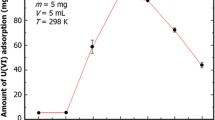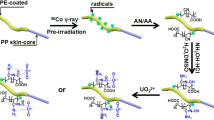Abstract
A new amidoxime-functionalized ultrahigh molecular weight polyethylene fibrous adsorbent (UHMWPE-g-PAO) was used for the recovery of Au(III) from acid aqueous solution. The maximum experimental absorption capacity of UHMWPE-g-PAO fiber was found to be approximately 220.0 mg·g−1. Au adsorption on UHMWPE-g-PAO was characterized by synchrotron radiation-based microcomputed tomography (SR-μ-CT), transmission electron microscopy (TEM), X-ray absorption near-edge structure spectroscopy (XANES) and synchrotron radiation-based Fourier transform infrared microspectroscopy (SR-FTIR). The SR-μ-CT and TEM results showed the distribution features of gold particles on the fiber. The mechanism of Au(III) recovery from aqueous solutions by UHMWPE-g-PAO was based on the adsorbed Au(III) ions, which were reduced to metallic zero-valent gold (Au(0)) by amino groups (–NH2) in the amidoxime (AO) groups during the adsorption process, as confirmed by high-resolution TEM (HRTEM) and XANES analyses. X-ray diffraction (XRD) results indicated that the incineration ashes contained metallic zero-valent gold. In conclusion, this amidoxime-functionalized fibrous adsorbent is a promising material for recovering gold from aqueous solution.








Similar content being viewed by others
References
Corti CW, Holliday RJ. Commercial aspects of gold applications: from materials science to chemical science. Gold Bull. 2004;37(1–2):20.
Zhang Y, Cui XJ, Shi F, Deng YF. Nano-gold catalysis in fine chemical synthesis. Chem Rev. 2012;112(4):2467.
Wang M, Wang F, Ma JP, Li MR, Zhang Z, Wang YH, Zhang XC, Xu J. Investigations on the crystal plane effect of ceria on gold catalysis in the oxidative dehydrogenation of alcohols and amines in the liquid phase. Chem Commun. 2014;50(3):292.
Cui JR, Zhang LF. Metallurgical recovery of metals from electronic waste: a review. J Hazard Mater. 2008;158(2–3):228.
Pant D, Joshi D, Upreti MK, Kotnala RK. Chemical and biological extraction of metals present in e waste: a hybrid technology. Waste Manag. 2012;32(5):979.
Zhang XL, Chen SY, Zhou L, Fan SM, Chen KH. Progress in recovery of platinum and palladium from spent catalysts by hydrometallurgical methods. Chin J Rare Met. 2018;42(12):1323.
Macaskie LE, Creamer NJ, Essa AM, Brown NL. A new approach for the recovery of precious metals from solution and from leachates derived from electronic scrap. Biotechnol Bioeng. 2007;96(4):631.
Liu G, Yan TL, Wu YZ, Yi XH, Chen B, Li RW. Polyaniline-poly(vinylidene fluoride) blend microfiltration membrane and its spontaneous gold recovery application. Sci China Chem. 2018;61(1):118.
Aguayo S, Valenzuela JL, Parga JR, Lewis RG, Cruz M. Continuous laboratory gold solvent extraction from cyanide solutions using LIX 79 reagent. Chem Eng Technol. 2007;30(11):1532.
Wang FC, Zhao JM, Wang WK, Tong ZZ. Adsorption of Au(III) by amino-modified monodispersed PGMA microspheres and the deposition of gold nanoparticles. Rare Met. 2018;37(3):196.
Firlak M, Yetimoǧlu EK, Kahraman MV, Apohan NK. Removal of lead and cadmium ions from aqueous solutions using sulphur and oxygen donor ligand bearing hydrogels. Sep Sci Technol. 2009;45(1):116.
Wojnicki M, Rudnik E, Luty-Błocho M, Socha RP, Pędzich Z, Fitzner K, Mech K. Kinetic studies of gold recovery from diluted chloride aqueous solutions using activated carbon organosorb 10 CO. Aust J Chem. 2015;69(3):254.
Wojnicki M, Luty-Błocho M, Socha RP, Mech K, Pędzich Z, Fitzner K, Rudnik E. Kinetic studies of sorption and reduction of gold(III) chloride complex ions on activated carbon Norit ROX 0.8. J Ind Eng Chem. 2015;29:289.
Wojnicki M, Socha RP, Luty-Błocho M, Partyka B, Polański M, Deszcz P, Kołczyk K, Żabiński P. Study of gold, copper and nickel adsorption, from their acidic chloride solutions, onto activated carbon. Arch Metall Mater. 2018;63(1):73.
Mohammadnejad S, Provis JL, Deventer JSJV. Gold sorption by silicates in acidic and alkaline chloride media. Int J Miner Process. 2011;100(3–4):149.
Xing Z, Wang MH, Liu WH, Hu JT, Wu GZ. Crystal structure and mechanical properties of UHMWPE-g-PMA fiber prepared by radiation grafting. Radiat Phys Chem. 2013;86:84.
Fisch AG Jr, Silveira ND, Cardozo NSM, Secchi AR, Santos JHZD, Soares JBP. Direct production of ultra-high molecular weight polyethylene with oriented crystalline microstructures. J Mol Catal A Chem. 2013;366:74.
Wan CX, Cao T, Li J, Lv F, Zhang WH, Li LB. Modification of UHMWPE porous fibers by acrylic acid and its adsorption kinetics for Cu2+ removal. Polym Bull. 2017;74(9):3855.
Hu JT, Ma HJ, Xing Z, Liu XY, Xu L, Li R, Lin CJ, Wang MH, Li JY, Wu GZ. Preparation of amidoximated ultrahigh molecular weight polyethylene fiber by radiation grafting and uranium adsorption test. Ind Eng Chem Res. 2016;55(15):4118.
Gao QH, Hu JT, Li R, Xing Z, Xu L, Wang MH, Guo XJ, Gz W. Radiation synthesis of a new amidoximated UHMWPE fibrous adsorbent with high adsorption selectivity for uranium over vanadium in simulated seawater. Radiat Phys Chem. 2016;122:1.
Pang LJ, Li R, Gao QH, Hu JT, Xing Z, Zhang MX, Wang MH, Wu GZ. Functionalized and reusable polyethylene fibres for Au(III) extraction from aqueous solution with high adsorption capacity and selectivity. RSC Adv. 2016;6(90):87221.
Xing Z, Hu JT, Wang MH, Zhang WL, Li SN, Gao QH, Wu GZ. Properties and evaluation of amidoxime-based UHMWPE fibrous adsorbent for extraction of uranium from seawater. Sci China Chem. 2013;56(11):1504.
Zhang YP, Ersoy O, Karatutlu A, Little W, Sapelkin A. Local structure of Ge quantum dots determined by combined numerical analysis of EXAFS and XANES data. J Synchrotron Radiat. 2016;23(1):253.
Ogata T, Nakano Y. Mechanisms of gold recovery from aqueous solutions using a novel tannin gel adsorbent synthesized from natural condensed tannin. Water Res. 2005;39(18):4281.
Qu RJ, Sun CM, Wang MH, Ji CN, Xu Q, Zhang Y, Wang CH, Chen H, Yin P. Adsorption of Au(III) from aqueous solution using cotton fiber/chitosan composite adsorbents. Hydrometallurgy. 2009;100(1–2):65.
Saman N, Rashid MU, Lye JWP, Mat H. Recovery of Au(III) from an aqueous solution by aminopropyltriethoxysilane-functionalized lignocellulosic based adsorbents. React Funct Polym. 2018;123:106.
Kanagare AB, Singh KK, Kumar M, Yadav M, Ruhela R, Singh AK, Kumar A, Shinde VS. DTDGA-impregnated XAD-16 beads for separation of gold from electronic waste solutions. Ind Eng Chem Res. 2016;55(49):12644.
Ebrahimzadeh H, Shekari N, Tavassoli N, Amini MM, Adineh M, Sadeghi O. Extraction of trace amounts of silver on various amino-functionalized nanoporous silicas in real samples. Microchim Acta. 2010;170(1–2):171.
Monier M, Akl MA, Ali W. Preparation and characterization of selective phenyl thiosemicarbazide modified Au(III) ion-imprinted cellulosic cotton fibers. J Appl Polym Sci. 2014;131(18):40769.
Shamspur T, Mostafavi A. Application of modified multiwalled carbon nanotubes as a sorbent for simultaneous separation and preconcentration trace amounts of Au(III) and Mn(II). J Hazard Mater. 2009;168(2–3):1548.
Wang HF, Bao CL, Li F, Kong XF, Xu JJ. Preparation and application of 4-amino-4′-nitro azobenzene modified chitosan as a selective adsorbent for the determination of Au(III) and Pd(II). Microchim Acta. 2010;168(1–2):99.
Albishri HM, Marwani HM. Chemically modified activated carbon with tris(hydroxymethyl)aminomethane for selective adsorption and determination of gold in water samples. Arab J Chem. 2016;9(S1):S252.
Gentscheva G, Tzvetkova P, Vassileva P, Lakov L, Peshev O, Ivanova E. Analytical characterization of a silica gel sorbent with thioetheric sites. Microchim Acta. 2006;156(3–4):303.
Fu LK, Zhang LB, Wang SX, Zhang GW, Peng JH. Selective recovery of Au(III) from aqueous solutions by nano-silica grafted with 4-(aminomethyl) pyridine. J Sol Gel Sci Technol. 2017;83(2):467.
Tofan L, Bunia I, Paduraru C, Teodosiu C. Synthesis, characterization and experimental assessment of a novel functionalized macroporous acrylic copolymer for gold separation from wastewater. Process Saf Environ Prot. 2017;106:150.
Langmuir I. The adsorption of gases on plane surfaces of glass, mica and platinum. J Am Chem. 1918;40(12):1361.
Freundlich HMF. Over the adsorption in solution. J Phys Chem. 1906;57:385.
Tanaka T, Ohyama J, Teramura K, Hitomi Y. Formation mechanism of metal nanoparticles studied by XAFS spectroscopy and effective synthesis of small metal nanoparticles. Catal Today. 2012;183(1):108.
Watzky MA, Finke RG. Transition metal nanocluster formation kinetic and mechanistic studies. A new mechanism when hydrogen is the reductant: slow, continuous nucleation and fast autocatalytic surface growth. J Am Chem Soc. 1997;119(43):10382.
Meire M, Tack P, Keukeleere KD, Balcaen L, Pollefeyt G, Vanhaecke F, Vincze L, Voort PVD, Driessche IV, Lommens P. Gold/titania composites: an X-ray absorption spectroscopy study on the influence of the reduction method. Spectrochim Acta Part B. 2015;110:45.
Sun CJ, Yang H, Yuan Y, Tian X, Wang LM, Guo Y, Xu L, Lei JL, Gao N, Anderson GJ, Liang XJ, Chen CY, Zhao YL, Nie GJ. Controlling assembly of paired gold clusters within apoferritin nanoreactor for in vivo kidney targeting and biomedical imaging. J Am Chem Soc. 2011;133(22):8617.
Choi SH, Nho YC. Radiation-induced graft copolymerization of binary monomer mixture containing acrylonitrile onto polyethylene films. Radiat Phys Chem. 2000;58(2):157.
Huang FL, Xu YF, Liao SQ, Yang DW, Hsieh YL, Wei QF. Preparation of amidoxime polyacrylonitrile chelating nanofibers and their application for adsorption of metal ions. Materials. 2013;6(3):969.
Parajuli D, Hirota K, Inoue K. Trimethylamine-modified lignophenol for the recovery of precious metals. Ind Eng Chem Res. 2009;48(23):10163.
Ma HJ, Chi HY, Wu JX, Wang M, Li JY, Hoshina H, Saiki S, Seko N. A novel avenue to gold nanostructured microtubes using functionalized fiber as the ligand, the reductant, and the template. ACS Appl Mater Interfaces. 2013;5(17):8761.
Philip D. Biosynthesis of Au, Ag and Au–Ag nanoparticles using edible mushroom extract. Spectrochim Acta A. 2009;73(2):374.
Acknowledgements
This study was financially supported by the National Natural Science Foundation of China (Nos. 21677116, 91543118, 11775289 and 11275256).
Author information
Authors and Affiliations
Corresponding authors
Rights and permissions
About this article
Cite this article
Liang, YL., Jin, C., Hu, JT. et al. A highly efficient pathway to recover gold from acid aqueous solution by using an amidoxime-functionalized UHMWPE fiber. Rare Met. 38, 1105–1112 (2019). https://doi.org/10.1007/s12598-019-01317-z
Received:
Revised:
Accepted:
Published:
Issue Date:
DOI: https://doi.org/10.1007/s12598-019-01317-z




